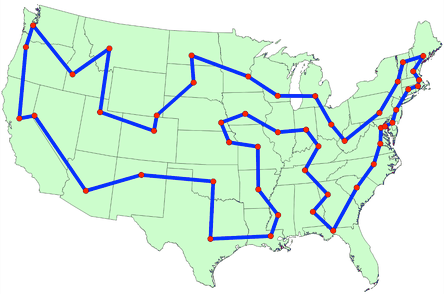Revolutionize your understanding of the Travelling Salesman Problem (TSP); a mind-boggling conundrum that has compelled academia and industry alike. In the upcoming lines, we decode the key concepts, algorithms, and anticipated solutions for 2024 to this age-old dilemma.
Now, picture the TSP as a globetrotting traveling salesman who’s whirlwind journey. He must stop at every city once, only the origin city once, and find the quickest shortest possible route back home. If daunting to visualize, consider this: the possible number of routes in the problem concerning just 20 cities exceeds the number of atoms in the observable universe.
Fathom the sheer magnitude?
So, what is the Travelling Salesman Problem, and why has it remained unsolved for years? Let’s snap together the puzzle of this notorious problem that spans mathematics, computer science, and beyond. Welcome to an insightful voyage into the astonishing world of the TSP. Delve deeper into how optimizing travel routes can transform the efficiency of solving the Travelling Salesman Problem, marking a milestone in the journey toward more effective logistics and navigational strategies.
Boost customer satisfaction with just a few clicks
Most-Loved Features:
- On-demand drivers
- Real-time GPS tracking
- Delivery confirmation photos
- Over 50% of customers report a smoother delivery experience
Understanding the Travelling Salesman Problem (TSP): Key Concepts and Algorithms
Defining the Travelling Salesman Problem: A Comprehensive Overview
The Travelling Salesman Problem, often abbreviated as TSP, has a strong footing in the realm of computer science. To the untrained eye, it presents itself as a puzzle: a salesperson or traveling salesman must traverse through a number of specific cities before an ending point and return to their ending point as of origin, managing to do so in the shortest possible distance. But this problem is not simply a conundrum for those fond of riddles; it holds immense significance in the broad field of computer science and optimization. Optimizing travel routes is the key to solving the Travelling Salesman Problem efficiently, ensuring the shortest and most cost-effective journey for salespeople or travelers.
The sheer computational complexity of TSP is what sets it apart, and incidentally, why it is considered a challenging problem to solve. Its complexity derives from the factorial nature of the problem: whenever a new city is added, the total number of possibilities increases exponentially. Thus, as the problem scope enlarges, it swiftly becomes computationally prohibitive to simply calculate all possible solutions to identify an optimal shortest route through. Consequently, developing effective and efficient algorithms to solve the TSP has become a priority in the world of computational complexity.
Polynomial Time Solution:
The TSP can be solved by a deterministic Turing machine in polynomial time, which means that the number of steps to solve the problem can be at most 1.5 times the optimal global solution.
One such algorithm is the dynamic programming approach that can solve TSP problems in polynomial time. The approach uses a recursive formula to compute the shortest possible route that visits all other nodes in the cities exactly once and ends at all nodes in the starting point or city. Moreover, linear programming and approximation algorithms have also been used to find near-optimal solutions. Discover how dynamic programming and other strategies serve as algorithms for optimizing routes, enhancing efficiency in plotting course paths.
Unraveling TSP Algorithms: From Brute Force to Heuristics
A multitude of algorithms have been developed to contend with the TSP. The brute force method, for example, entails considering the shortest distance for all possible permutations of cities, calculating the total distance for six cities along each route, and selecting the shortest distance for one. While brute force promises an optimal solution, it suffers from exponential computational complexity, rendering it unfeasible for large datasets.
TSP Complexity:
A TSP with just 10 cities has 362,880 possible routes, making brute force infeasible for larger instances.
On the other hand, we have heuristic algorithms that generate good, albeit non-optimal, solutions in reasonable timeframes. The greedy algorithm, for instance, initiates from a starting city and looks for the shortest distance from other nodes to the next node minimizes the distance, and guarantees speed but is not necessarily an optimal solution.
Algorithmic Potential: Local Solutions 4/3 Times Optimal Global:
The theoretical conjecture suggests an algorithm that can provide a local solution within 4/3 times the optimal global solution.
Record Local TSP Solution:
The record for a local solution to the Traveling Salesman Problem (TSP) is 1.4 times the optimal global solution, achieved in September 2012 by Andr´as Seb˝o and Jens Vygen.
Exploring further, we encounter more refined heuristic solutions such as the genetic algorithm and simulated annealing algorithm. These algorithms deploy probabilistic rules, with the former incorporating principles of natural evolution and the latter being inspired by the cooling process in metallurgy. They differ significantly from each other in terms of how they search for solutions, but when compared to brute force, they often offer a promising trade-off between quality and computational effort.
Certainly, the TSP is far more than a problem to puzzle over during a Sunday afternoon tea. It’s a complex computational task with real-world implications, and unraveling it requires more than brute force; it demands the application of sophisticated algorithms designed to balance efficiency and quality of results. Nevertheless, with a better understanding of the problem statement and its dynamics, you can unlock the potential to not just solve problems faster, but to do so more intelligently.
Practical Solutions to the Travelling Salesman Problem
Implementing TSP Solutions: A Step-by-Step Guide
A comprehensive process for implementing TSP Solutions
Developing complete, practical solutions for the Travelling Salesman Problem (TSP) requires a good grasp of specific algorithms. Visual aids, for example, such as finding all the edges leading out of a given city, can help to simplify the process. Enhance your ability to solve the Travelling Salesman Problem by mastering route optimization with Google Maps, streamlining your path and saving significant time on the go.
TSP's Computer Science Quest for Shortest Routes:
The TSP involves finding the shortest route to visit a set of cities exactly once before returning to the starting city, aiming to minimize travel distance.

One popular approach to TSP problem solving is the dynamic programming approach, which involves breaking down the problem into smaller sub-problems and recursively solving them. Other approaches include approximation algorithms, which generate near-optimal solutions to small problems in polynomial time, and bound algorithms, which aim to find an upper bound on the optimal solution given graph top. Discover how software for planning routes can revolutionize your approach to the TSP problem, offering near-optimal solutions that enhance efficiency and effectiveness in logistical planning.
TSP Variants: ASTP and STSP
The TSP can be divided into two types: the asymmetric traveling salesman problem (ASTP) and the symmetric traveling salesman problem (STSP)
Practical code implementation
Before diving into code manipulations, it’s worth noting that practical implementation varies based on the specifics of the problem and the chosen algorithm. Let’s further deconstruct these notions by examining the steps for code implementation for a pre-determined shortest path first. It’s crucial to efficiently concede each point of the shortest path, call other nodes, connect each node, and conclude each route. Hereby, I shall delve into the practicalities of coding from an output standpoint, concentrating on readability, scalability, and execution efficiency. Uncover how optimizing routes can elevate your coding practices for more efficient, scalable, and readable solutions in logistics and transportation.
TSP Instance Size:
The size of the TSP instances used in the studies is 100 nodes.
Cluster Quantity in TSP Instances:
The number of clusters in the TSP instances used in the studies is 10.
The Quantity of Instances per Cluster in Studies:
The number of instances in each cluster used in the studies is 100.
Optimizing TSP Solutions: Tips and Tricks
TSP Solutions Optimization Techniques
An optimized solution for the TSP is often accomplished using advanced algorithms and techniques. Optimization techniques allow professionals to solve more intricate problems, rendering them invaluable tools when handling large datasets and attempting to achieve the best possible solution. Several approaches can be taken, such as heuristic and metaheuristic approaches, that can provide near-optimal solutions with less use of resources. Discover the key to enhancing your logistics operations by mastering the art of optimizing delivery routes, thereby achieving efficiency and reducing costs significantly.
Expert Advice for Maximum Efficiency Minimum Cost
Even the most proficient problem solvers can gain from learning expert tips and tricks. These nuggets of wisdom often provide the breakthrough needed to turn a good solution into a great one. The TSP is no exception. Peering into the realm of experts can provide novel and creative ways to save time, increase computation speed, manage datasets, and achieve the most efficient shortest route around. Unlock the full potential of your journeys by mastering how to enhance your travel strategies with Google Maps route optimization.
By comprehending and implementing these solutions to the Travelling Salesman Problem, one can unravel the complex web of nodes and paths. This equips any problem-solver with invaluable insights that make navigating through real-world TSP applications much more manageable. By adopting sophisticated routing planner software, businesses can significantly streamline their delivery operations, ensuring a more predictable and cost-effective way of dealing with the challenges presented by the Travelling Salesman Problem.
Real-World Applications of the Travelling Salesman Problem
TSP in Logistics and Supply Chain Management
The Travelling Salesman Problem (TSP) is not confined to theoretical mathematics or theoretical computer science either, it shines in real-world applications too. One of its most potent applications resides in the field of logistics and supply chain management. Explore how the latest gratis route planning applications can revolutionize logistics and supply chain efficiency by uncovering the top 10 free software tools for 2024.
With globalization, the importance of more efficient routes for logistics and supply chain operations has risen dramatically. Optimizing routes and decreasing costs hold the key to success in this arena. Here’s where TSP comes into play. Discover how Planning for Multiple Stops can revolutionize your logistics, ensuring the most efficient paths are taken. Dive into our post to see how it streamlines operations and reduces expenses.
In the vast complexity of supply chain networks, routing can be a colossal task. TSP algorithms bring clarity to the chaos, eliminating redundant paths and pointing to the optimal route covering the most distance, shortest path, and least distance between all the necessary points—leading to a drastic dip in transportation costs and delivery times. Uncover how optimizing delivery routes can revolutionize your logistics, ensuring efficiency and cost-effectiveness in your delivery operations.
Real-World Examples
Consider the case of UPS – the multinational package delivery company. They’ve reportedly saved hundreds of millions of dollars yearly by implementing route optimization algorithms originating from the Travelling Salesman Problem. The solution, named ORION, helped UPS reduce the distance driven by their drivers roughly by 100 million miles annually. Understand the intricacies of the problem of routing vehicles to appreciate how businesses like UPS can significantly benefit from efficient logistical strategies and route optimization systems.
TSP in GIS and Urban Planning: Optimal Route
TSP’s contributions to cities aren’t confined to logistics; it is invaluable in Geographic Information Systems (GIS) and urban planning as well. A city’s efficiency revolves around transportation. The better the transport networks and systems, the higher the city’s productivity. And as city authorities continuously strive to upgrade transportation systems, they find an ally in TSP. Discover how TSP enhances road architecture by integrating specialized truck routing solutions, elevating urban transport strategies.
Advanced GIS systems apply TSP to design more efficient routes and routing systems for public transportation. The aim of the route is to reach maximum locations with the least travel time and least distance, ensuring essential amenities are accessible to everyone in the city. Discover how dynamic routing optimization can enhance city-wide transportation efficiency and accessibility for all residents.
Real-World Examples
The city of Singapore, known for its efficient public transportation system, owes part of its success to similar routing algorithms. The Land Transport Authority uses TSP-related solutions to plan bus routes, reducing travel durations and enhancing accessibility across the city.
Delving Deeper: The Complexity and History of the Travelling Salesman Problem
Understanding the Complexity of TSP
TSP is fascinating not just for its inherent practicality but also for the complexity it brings along. TSP belongs to a class of problems known as NP-hard, a category that houses some of the most complex problems in computer science. But what makes TSP so gnarled?
Unravel the Intricacies: Why is TSP complex?
TSP is a combinatorial optimization problem, which simply means that it’s all about figuring out the most often optimal solution among a vast number of possible solutions or combinations of approximate solutions. The real challenge comes from an innocent-sounding feature of TSP: As the number of cities (we call them nodes) increases, the complexity heightens exponentially, not linearly. The number of possible routes takes a dramatic upward turn as you add more nodes, clearly exemplifying why TSP is no walk-in-the-park problem. Discover how leveraging multi-stop itinerary planning can transform this complex task, offering a streamlined solution to navigate through the myriad of possibilities efficiently.
NP-hard and TSP: A Connection Explored
In computer science, we use the terms P and NP for classifying problems. P stands for problems where a solution can be found in ‘polynomial time’. NP stands for ‘nondeterministic polynomial time’, which includes problems where a solution can be verified in polynomial time. The concept of ‘NP-hardness’ applies to TSP. Any problem that can be ‘reduced’ to an NP problem in polynomial time is described as NP-hard. In simpler terms, it’s harder than the hardest problems of NP. TSP holds a famed position in this class, making it a noteworthy example of an NP-hard problem. Discovering efficient solutions for the Traveling Salesman Problem (TSP) exemplifies how optimizing routes can streamline complex logistical challenges, showcasing the practical impact of advancements in algorithmic route optimization.
A Look Back: The History of the Travelling Salesman Problem
TSP is not a new kid on the block. Its roots can be traced back to the 1800s, and the journey since then has been nothing short of a compelling tale of mathematical and computational advancements. Leverage the power of route optimization through Google Maps to navigate the complexities of TSP with efficiency and ease.
The Origins and Evolution of TSP
Believe it or not, the Travelling Salesman Problem was first formulated as a mathematical problem in the 1800s. This was way before the advent of modern computers. Mathematicians and logisticians were intrigued by the problem and its implications. However, it wasn’t until the mid-20th century that the problem started to gain more widespread attention. Over the years, the TSP has transformed from a theoretical model to a practical problem that helps solve real-world issues.
A Classic Shortest Route Problem Since 1930s:
The TSP is a classic optimization problem within the field of operations research, first studied during the 1930s.
Milestones in TSP Research
Looking at all the cities and milestones in TSP research, the story is truly impressive. From some of the initial heuristic algorithms to solve smaller instances of TSP, to geometric methods and then approximation algorithms, TSP research has seen a lot. More recently, we have also seen practical solutions to TSP using quantum computing — a testament to how far we’ve come. Each of these milestones signifies an innovative shift in how we understand and solve TSP. Discovering the top delivery route planning software in 2024, we navigated through the advancements in TSP solutions to identify which applications excel in streamlining delivery logistics.
Wrapping Up The Journey With Algorithms and Solutions
The Travelling Salesman Problem (TSP) remains a complex enigma of business logistics, yet, the advent of sophisticated algorithms and innovative solutions are paving avenues to optimize routing, reduce travel costs further, and enhance customer interactions.
Navigating the TSP intricacies is no longer a daunting challenge but a worthwhile investment in refining operational efficiency and delivering unparalleled customer experiences. With advanced toolsets and intelligent systems, businesses are closer to making more informed, strategic decisions. Elevate your logistical operations and customer satisfaction with the strategic integration of route scheduling solutions.
Now, it’s your turn. Reflect on your current logistics complexities. How can your business benefit from implementing these key concepts and algorithms? Consider where you could incorporate these practices to streamline and revolutionize your daily operations.
Remember, in the world of dynamic business operations, mastering the TSP is not just an option, but a strategic imperative. As you move forward into 2024, embrace the art of solving the TSP. Unravel the potential, decipher the complexities, and unlock new horizons for your business.
Ready for the challenge?














